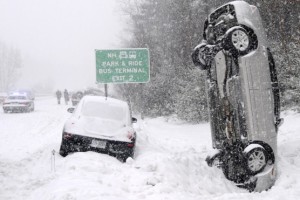Illinois State Police Winter Driving Tips:
Driving during winter weather conditions is sometimes hazardous at best. Below is some information you may find useful as you prepare to confront the winter season.

If you must use your car during a storm…
Plan your travel, selecting both primary and alternate routes.
Let someone know your travel routes and itinerary so that, if you don’t arrive on time, officials will know where to search for you.
Check latest weather information on your radio.
Try not to travel alone – two or three people are preferable.
Travel in convoy (with another vehicle) if possible.
Drive carefully and defensively. Watch for ice patches on bridges and overpasses.
If a storm begins to be too much for you to handle, seek refuge immediately.
If your car should become disabled, stay with the vehicle, running your engine and heater for short intervals. Be sure to “crack” a window in the vehicle to avoid carbon monoxide build-up.
Reliable transportation is especially important in the winter. If you have a car, make sure it is ready for whatever winter may bring. Not only should your car be kept in top operating condition all year round – for safety and fuel economy, it is especially important to get it winterized to avoid any unpleasant or dangerous situation while traveling in frigid weather.
The following should be checked:
ignition system
fuel system
brakes
exhaust system
wiper blades
snow tires
tire tread
defroster
proper grade oil
cooling system
battery
lights
antifreeze
Always fill the gasoline tank before entering open country, even for a short distance, and stop to fill-up long before the tank begins to run low. Keeping your tank as full as possible will minimize condensation, providing the maximum advantage in case of trouble. A Citizens Band (CB) radio and/or cellular phone can be very useful to you or another stranded motorist in case of an emergency.
Coffee Can Survival Kit…
Here’s how to make your own:
2 or 3 pound coffee can (punch 3 holes at the top of can, equal distance apart)
60-inch length of twine or heavy string (cut into 3 equal pieces – used to suspend can)
3 large safety pins (tie string to safety pins and pin to car roof interior to suspend can over candle)
1 candle 2″ diameter (place on lid under suspended can for melting snow)
1 pocket knife, reasonably sharp (or substitute with scissors)
3 pieces of bright cloth 2″ wide x 36″ long (tie to antenna or door handle)
Several packets of soup, hot chocolate, tea, bouillon cubes, etc. (mixed into melted snow to provide warmth and nutrition)
1 small package of peanuts (provides protein) & fruit-flavored candy (orange slices, jelly beans, etc.-avoid chocolate)
1 pair of athletic socks (cotton) and 1 pair of glove liners (cotton)
2 packages of book matches
1 sun shield blanket or 2 large green or black plastic leaf bags (to reflect body heat)
1 pen light and batteries (keep separate)
When complete, place stocking cap over kit and carry in passenger compartment of car. If you have a 3 pound can, you will still have additional room for band-aids, aspirin, small radio, etc. If there is still room left, increase the quantity of any of the above items or improvise items you feel might be necessary.
Remember hypothermia (rapid loss of body temperature) can happen to anyone!
Stay in your car until help arrives!
An accident or severe weather situation can occur at any time. Your driver must be aware of the effects of cold weather in the event he or she becomes stranded.
Be Alert To Frostbite Conditions
Exposed skin can freeze within one minute at wind-chill equivalent temperatures below -25 F. Frostbite affects the extremities, such as fingers and toes. If a body part has been frostbitten once, it is more susceptible to frostbite again, even in milder conditions. Redness and a burning sensation are indications frostbite will occur unless the extremity is warmed. Numbness is an indication that frostbite has already taken place. If frostbite is discovered, hold the affected part tightly against the warm skin or another part of the body; (for example place frozen fingers under arm). When thoroughly warmed, keep covered and make an effort to keep area from freezing again.
Hypothermia
Under conditions of prolonged exposure to cold, the body may begin to lose heat faster than it can produce it. A condition called hypothermia begins to develop. The symptoms become very apparent, and include:
uncontrollable shivering
vague, slow, slurred speech
memory lapses
incoherence
immobile, fumbling hands
frequent stumbling
lurching gait
drowsiness
apparent exhaustion
Wind-Chill Equivalent Temperatures
The true effect of winter weather on your body can be deceiving. While the air temperature may not seem too cold, the wind may increase its effect. To find the wind chill, find the actual air temperature in the “Calm Air” column, then look for the corresponding value under the column closest to the current air speed. For example, if the actual air temperature is 20 degrees Fahrenheit, a wind speed of 30 mph makes the air feel like -18 degrees.
By: Frank Sacco
Source: Illinois State Police


